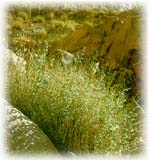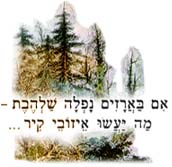|

“This shall be the
law of the leper on the day of his cleansing... The priest shall command
for him...cedar wood...and...hyssop.” (Lev. 14:2-4)
“Said Rabbi Isaac bar Tavlai: [1]
What is the significance of cedar wood and hyssop for the leper? They
say to him: You were proud like the cedar, and the Holy One, Blessed be
He, humbled you like this hyssop that is crushed by everyone.” [2] |
While pride is symbolized by the lofty cedar tree in Jewish
tradition, the lowly hyssop represents modesty and humility. The hyssop (Majorana
syriaca (L.) Rafin, or Origanum syriacum (L.) Sieb; ezov in
Hebrew) is a grayish shrub with thin woody branches; neither its leaves nor
its flowers are outstanding in any way. It makes do with very little, sometimes
even growing out of the smallest cracks in stone (“in the rock” [3]),
yet it is highly valued for its fragrance and flavor. The hyssop is an important
spice and medicinal plant, while its dry branches are excellent kindling. The
best known food made from the hyssop in the Middle East is a powder known by
its Arabic name, za’tar. It is a mixture of crushed or powdered
hyssop leaves, sesame seeds, ground sumac fruit, salt and pepper.
The words of Rabbi bar Tavlai, “the hyssop is crushed by all,” reflect
its widespread use for spice, fragrance and medicine. Yet the lowly hyssop never
becomes proud because of its numerous useful qualities, but remains humble in
appearance and modest in its demands.
This symbolism of the hyssop versus the
cedar also helps us to understand the entreaty of King David after the prophet
Nathan rebukes him for his deeds with Bathsheba: “Cleanse me with hyssop
that I may be pure; wash me that I may become whiter than snow.”[4]
By taking Bathsheba as he did, David arrogantly accorded himself the unjust
privileges assumed by foreign kings, thus “he became proud above his people.”
David’s prayer for forgiveness can be understood like the plea of the leper:
I was proud and haughty like the cedar, and now I beseech you to make me humble
like this hyssop with which I ask to be cleansed.
Hyssop: moss
or shrub?
“Go, pick out lambs for your families, and slaughter the Passover offering.
Take a bunch of hyssop, dip it in the blood that is in the basin, and apply
some of the blood that is in the basin to the lintel and to the two doorposts.”
(Exodus 12:21-22)
For many years, especially in European countries, it was accepted that the biblical
ezov was moss or lichen, that short, clumpy plant growing on tree trunks,
rocks and walls, frequently on the shaded, moist northern exposure. Rashi [5]
objects to this identification (in his commentary on Exodus 12:22), saying:
“Ezov is a plant that has branches.” Many places in the writings
of the Sages indicate that ezov has branches. For instance: “The ezov
was dipped with its stem and its branches...”
[6] it is impossible, therefore, for the hyssop
to be moss or lichen, which does not have visible branches and of which it certainly
cannot be said that it could be “dipped with its stem and its branches.”
 Then,
too, there is the saying, “If a flame catches the cedars, what will the
hyssop in the rock do?” Despite its Biblical sounding language, this comes
from the Gemara, [7]
from the eulogy recited by the famed orator Bar-Kipok over Rav Ashi.[8]
This saying gives us additional proof that the hyssop is “a kind of tree”
whose branches easily catch fire. If the hyssop were really moss growing on
rock faces, this saying could never have been composed. For what danger is there
for the moist, spongy moss, growing in damp places, even when the mighty cedars
of Lebanon catch fire? Then,
too, there is the saying, “If a flame catches the cedars, what will the
hyssop in the rock do?” Despite its Biblical sounding language, this comes
from the Gemara, [7]
from the eulogy recited by the famed orator Bar-Kipok over Rav Ashi.[8]
This saying gives us additional proof that the hyssop is “a kind of tree”
whose branches easily catch fire. If the hyssop were really moss growing on
rock faces, this saying could never have been composed. For what danger is there
for the moist, spongy moss, growing in damp places, even when the mighty cedars
of Lebanon catch fire?
Ibn Ezra[9]
in his commentary on this same passage (Exodus 12:22) says: “the Gaon identified
hyssop with the Arabic za’tar, oregano in the foreign language, which is
not of the most important spice plants. It is not possible that the Gaon is
right, because the Bible says that ‘the hyssop grows in the rock’
and therefore I do not know what it is. However, it seems that it cannot be
a large plant because it is the opposite of the cedar mentioned in the verse.”
It seems the Ibn Ezra was not familiar with the hyssop’s various habitats,
one of which is rock outcroppings, as can be seen in all the hilly regions of
Israel. Therefore he did not accept the Gaon’s identification.

Because the ezov is
a plant with a woody stem and branches, it is listed among the trees of which
Solomon spoke: “He discoursed of the trees, from the cedar of Lebanon to
the hyssop that grows in the rocks.” [10]
Solomon spoke of trees, from the most mighty to the most lowly, from the most
haughty to the most humble.
|
[1]
Amora (scholar) in Palestine in the third generation (290-320). [back]
[2] Midrash Hagadol, Metzora 14 [back]
[3] I Kings 5:13 [back]
[4] Psalms 51:9 [back]
[5] Rabbi Shlomo Yitzhaki; lived in France and
Germany in the 11th century. The most popular and authoritative commentator
on the Bible and Talmud, his works became the bases for most later traditional
biblical and Talmudic commentaries. [back]
[6] Tosefta Parah 12:3 [back]
[7] Moed Katan 25b [back]
[8](Rabbana): greatest Babylonian amora
of the sixth (375-425) generation; redactor of the Babylonian Talmud; for
almost sixty years served as head of the Academy of Sura. His contemporaries
said of him: “never since the days of Rabbi Judah ha-Nasi were learning
and greatness combined in one person as they were in Rav Ashi.” [back]
[9] Twelfth-century scholar from Spain; most
widely studied biblical commentator after Rashi. [back]
[10] I Kings 5:13 [back] |
|
From
Tree and Shrub in our Biblical Heritage by Nogah Hareuveni. Translated
from Hebrew and adapted by Helen Frenkley. A publication of Neot
Kedumim Ltd., The Biblical Landscape Reserve in Israel.
|
|